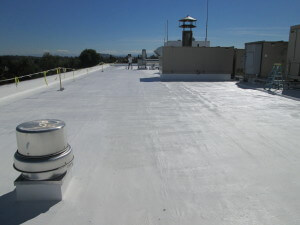
Reflective Roof Membrane Research Highlights from LBNL Heat Island Group
In a recent study, a cost-competitive reflective roof membrane reduced the average summertime daily maximum roof-surface temperature of a retail store in Austin, Texas, from 168°F (76°C) to 126°F (52°C). The total air-conditioning energy use was thereby reduced by 11% and peak air-conditioning demand fell by 14%. This 100,000 square foot building is predicted to save about $65,000 over the life of the roof.A reflective roof is typically light in color and absorbs less sunlight than does a conventional dark-colored roof. Less absorption of sunlight lowers the roof’s surface temperature, reducing the heat transfer through the roof. Thus, reflective roofs reduce air-conditioning (a/c) energy use. The magnitudes of energy savings depend upon building type, level of roof insulation, ventilation rate between roof and ceiling, a/c size and efficiency, and of course, roof solar reflectance.
In this study, sponsored by the U.S. Environmental Protection Agency (EPA) and the U.S. Department of Energy (DOE), the Heat Island Group at the Lawrence Berkeley National Laboratory measured and analyzed summertime air-conditioning energy savings and power-demand reduction of a large retail store in Austin, Texas, that was retrofitted with a reflective roof. The monitoring period was from August 1999 to September 2000. At 15-minute intervals, we measured the a/c energy use, total building energy use, temperatures at a variety of locations (including the roof surface, the bottom of the roof, the plenum between the roof and the ceiling, and the conditioned space), and climate parameters (ambient temperatures, wind speed and direction, and solar intensity). The building was monitored with its original black roof from August 1999 to April 2000. In April and May 2000, this roof was replaced with a white one membrane. We continued to monitor the building with its new white roof from late May through September 2000.
The average daily maximum roof-surface temperature for the black roof was 168°F (76°C). For the white roof it was reduced to 126°F (52°C). Similarly, the average maximum plenum temperature was reduced from 101°F (38°C) to 95°F (35°C). The average daily a/c savings were 355 kilowatt-hours (11% of total a/c use, saving about $750/month) and the peak-demand reduction was 35 kilowatts (14% of peak a/c demand, saving about $490/month) in the summer. We estimate that the installation of this cool roof saves over 60 megawatt-hours per year; the total annual energy- and peak-demand savings are estimated at $7,200. The total discounted savings over the expected life of the roof are estimated to be $60,000 to $70,000.
Reference: Konopacki, S. and H. Akbari. 2001. “Measured Energy Savings and Demand Reduction from a Reflective Roof Membrane on a Large Retail Store in Austin,” Lawrence Berkeley National.





